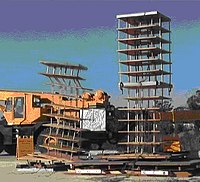
Photo from wikipedia
Abstract Vehicular crashes into buildings seem to be an on-going problem with severe consequences. When the building is of masonry, the damage at the impact zone is more severe with… Click to show full abstract
Abstract Vehicular crashes into buildings seem to be an on-going problem with severe consequences. When the building is of masonry, the damage at the impact zone is more severe with possible intrusion of the vehicle into the building, depending on the velocity of impact. In all these cases, vibration is propagated from the impact zone to the wall edges and then to adjoining walls in the building and can result in their damage. While the damage at the impact zone has been studied, the vibration propagation to the edges of the impacted wall and the adjoining walls and their potential for damage have not been treated. Dynamic response and damage of masonry walls due to vibration caused by vehicular impacts is important for the global safety assessment of the masonry structures. With this in mind, this paper presents a numerical study on the vibration-induced damage characteristics of the masonry structures subjected to vehicular impacts. A homogenised masonry material model incorporating strain rate effects suitable for impact applications using layered shell elements is adopted in this research with improved computational efficiency. The vibration induced damage at the edges of masonry walls is studied through numerical models of various types of wall structures. A validated vehicle model with deformable characteristics is employed to predict the HIC (Head Injury Criteria) to evaluate the head injury risk of the occupants of the vehicle when it crashes into the masonry structure. The outcomes of this study demonstrated that the vibration-induced damage in unreinforced masonry structures due to vehicular collision is more severe at low velocities compared that at high-velocity impacts. Moreover, the HIC value calculated for impacting vehicle velocity of 100 km/hr is 23.5, which is considerably lower than the HIC tolerance limit of 1000. This is a desirable safety feature for the occupants of the impacting vehicle, and it is due to the significant amount of energy absorbed at the impact zone and through the vibration transmission across the masonry wall.
Journal Title: Engineering Structures
Year Published: 2021
Link to full text (if available)
Share on Social Media: Sign Up to like & get
recommendations!